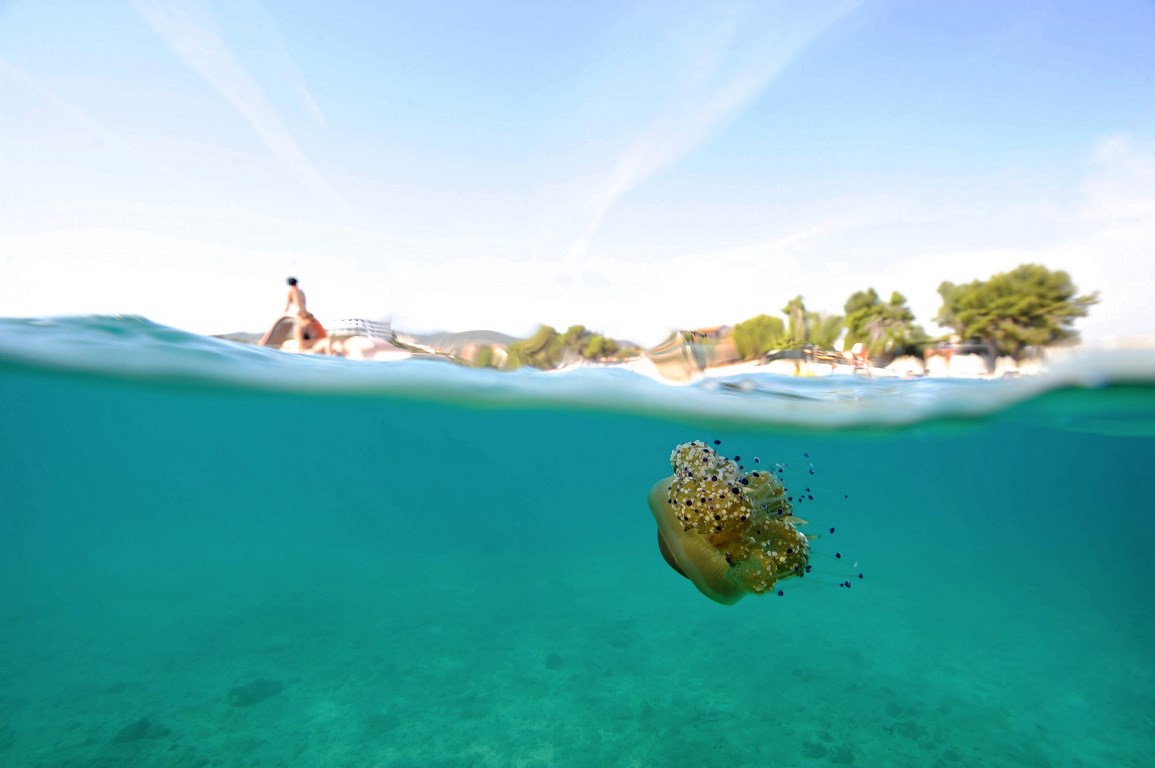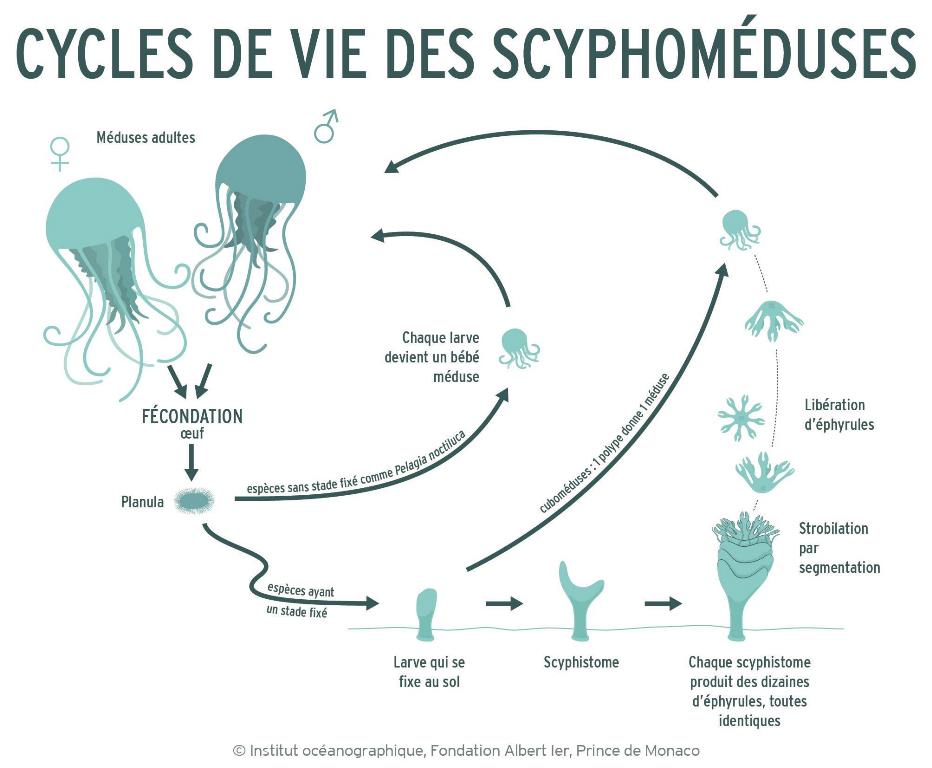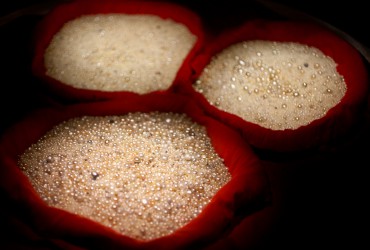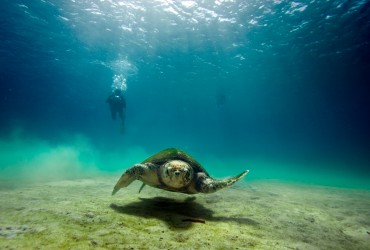Strange invasions
In a matter of days in November 2007, John Russel saw his entire stock of organic farmed salmons, almost 400’000 individuals, wiped out by an overwhelming swarm of jellyfish. “The bay was red and thick, he remembers. I had never seen anything like it.”
Russel is the managing director of the only salmon farm on the East coast of Ireland. Nine years ago, his business crumbled before his eyes. “The run up to that particular day was fine, with clear seas and normal weather, Russel told me. At half past eight on the morning of the harvest, I got a phone call from my staff saying the boats were struggling to get out. When I got to the port, I understood. Billions of tomato-sized jellyfish were floating in the bay, and they were blocking the boats’ engines.” The crew spent two and a half hours forcing its way to reach the pen where the mature farmed fish were kept, and the sight was a depressing one. Visibly overwhelmed by the invasion, the salmons sank to the bottom of the nets where they all lied up on top of each other. “They were dying before our eyes, suffocating.”
Russel and his team had never seen this species of jellyfish before. “They were small enough to go through the nets, he recalls, and there were too many of them. The swarm covered the surface from one of our farms to the other, 11 miles (18 kilometers) apart. The report later said they were down to 25 meters deep. I decided we should better check if they were stinging jellyfishes, so I held a couple of them in my hand.”
After a minute, Russel could feel a mild numbing, synonym of catastrophe. Indeed, a new ruling had come out that year in the EU stating that any salmon that was killed by a jellyfish invasion had to be incinerated. “You can imagine how big a clean up job that was, he says. Not only did it take us days, but our business ultimately closed down. We lost around 2.5 million pounds sterling and the government didn’t assist us in any way. Luckily, in April of 2008 we were able to start fresh with new owners who bought us out.” Today, Glenarm Organic Salmon Ltd. is still the only salmon farm on the East coast of Ireland.
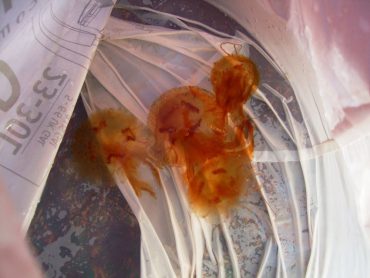 What John Russel witnessed is one of the most impressive, unpredictable and devastating occurrence in the marine environment: a jellyfish bloom. Their ability to spawn millions of individuals in a very short period of time is the marine equivalent of the Bible’s locust outbreak. In 2007, the coast of Ireland was overwhelmed by a bloom of Pelagia noctiluca, a species mainly known for its abundance in the Mediterranean Sea. What was it doing in such vast numbers this far in the North Atlantic? Did a massive bloom occur in the Mediterranean, got sucked out through the Strait of Gibraltar and into the Gulf Stream?
What John Russel witnessed is one of the most impressive, unpredictable and devastating occurrence in the marine environment: a jellyfish bloom. Their ability to spawn millions of individuals in a very short period of time is the marine equivalent of the Bible’s locust outbreak. In 2007, the coast of Ireland was overwhelmed by a bloom of Pelagia noctiluca, a species mainly known for its abundance in the Mediterranean Sea. What was it doing in such vast numbers this far in the North Atlantic? Did a massive bloom occur in the Mediterranean, got sucked out through the Strait of Gibraltar and into the Gulf Stream?
“It’s highly unlikely” answers Fabien Lombard, French plankton specialist at the Oceanological Observatory of Villefranche-sur-Mer. In his sea-level office with a beautiful view of the bay, he explains: “The way the water spills out of the Mediterranean is thoroughly studied and now well known, and it’s only the deep and super-salty pockets of water 600-700 meters below the surface that can be pushed North. The plankton, along the surface waters, usually head South, caught by the main current along the Spanish coast. Even if this species of jellyfish is mainly studied in the Mediterranean, we know there are populations in the Atlantic and in other oceans. In my opinion, it’s one of those strains that got caught in an oscillation of the Gulf Stream or by strong winds and ended up crashing against the Irish coasts, causing the damage we know in 2007.”
The exact causes of jellyfish blooms are still under scrutiny. However, we know that they are closely related to the reproduction cycles. These cycles vary radically from one species to another, thus the origins of blooms vary accordingly. For example, the Pelagia noctiluca is a jellyfish that spends its entire life floating in the water column, laying its eggs regardless of the state of the ecosystem. In the winter, when the water column of the Mediterranean is relatively poor in zooplankton, most of the fertilized eggs go to waste due to undernourishment.
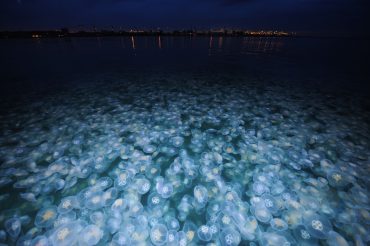 In the springtime, when sunlight hours increase, the phytoplankton is able to create vast quantities of organic matter through photosynthesis. This provides the food for the zooplankton, which increases exponentially. The bottom levels of the food chain gets richer, feeding in abundance the upper levels. The more the Pelagia noctiluca have to eat, the more rapidly they grow and develop their functional reproductive organs. Most probably, with this species, it is a combination of ideal conditions, food abundance and concentrated populations of juveniles and adults that spark a bloom.
In the springtime, when sunlight hours increase, the phytoplankton is able to create vast quantities of organic matter through photosynthesis. This provides the food for the zooplankton, which increases exponentially. The bottom levels of the food chain gets richer, feeding in abundance the upper levels. The more the Pelagia noctiluca have to eat, the more rapidly they grow and develop their functional reproductive organs. Most probably, with this species, it is a combination of ideal conditions, food abundance and concentrated populations of juveniles and adults that spark a bloom.
Everything gets more complicate with other species that don’t spend all of their life floating in the water column, but also have what can be described as an “attached state”. It’s the case for the Aurelia aurita or “moon jellyfish”, for example. All of the individuals we can observe swimming in the sea are either male or female medusae. When an egg is spawned by a female and fertilized by a male, the larvae may become a baby medusa under the right circumstances. But when the conditions do not permit this, the larvae may falls to the bottom of the sea to become a polyp, a tiny vertical tube ended by a unique orifice, both mouth and anus, and surrounded by stinging micro tentacles.
The polyp stays attached to the seafloor, patiently feeding on passing zooplankton, sometimes for months or years. It can reproduce asexually, cloning itself to colonize the surrounding area, always waiting for the right moment. Then, when all the conditions align – for the Aurelia, a complex and precise variation in water temperature – something almost magical happens: Each polyp releases microscopic baby jellyfishes, a unique process known as strobilation. Sometimes, an entire colony covering the ocean floor releases hundreds, thousands or millions of jellyfish at the same time, resulting in a massive bloom ready to be taken away by ocean currents and dominant surface winds.
“These are such localized events, says Jacqueline Goy, that their observations are punctual and highly subjective. If a scientific vessel or laboratory staff aren’t directly on the zone of the bloom, it can go totally unnoticed.” Jacqueline Goy is an 80-years-old French scientist that dedicated her life to the study of jellyfish. Since the 1960s, she wrote numerous scientific articles and books on the subject, such as the 2014 “Jellyfish’s conquest of the oceans”. “We still have a lot to learn, she says. New species are still being discovered. Only last month (September 2016) did I describe a new one”. In her own words, she is from the “old-school” and saw the worrying change in the ecosystems. Today, she is convinced that the oceanic system is slowly and dangerously shifting towards a more gelatinous one.
“First of all, Goy clarifies, you have to understand that it is impossible to generalize when it comes to jellyfish. Some are abundant while others are very rare. Some stay close to the surface while others swim in the depths and are hardly ever seen. One species will live several years and grow up to 6.5 meters long, and others will never be over 2 millimeters long. When the latter blooms, the sea turns to some sort of tapioca.”
According to Jacqueline Goy, a prey-predator balanced ecosystem was well established in the oceans up until the late 1990s and early 2000s. “Then we took the fish out of the equation, she adds, and the whole system collapsed.” Medusae don’t have a lot of predators. Sunfish and marine turtles are the known animals to feed almost exclusively on them, and their populations are struggling worldwide according to the International Union for the Conservation of Nature (IUCN). “Turtles are disappearing, Goy says, and there are very few specimens of sunfish and other schedophilus medusophagus. We are also preoccupied by tunas, because they regulate the jellyfish populations in the Mediterranean when they cross it to breed.”
Not only are the natural predators in fewer numbers, overfishing also took care of the competition in some places. In her 2014 book “Jellyfish’s conquest of the oceans”, Jacqueline Goy tells the tale of the Benguela marine current, a textbook case of mismanagement. Up until the 1950s, it was one of Namibia’s marine wildlife hotspot. Cold and nutrient rich waters upwell from the depths of the Atlantic Ocean, feeding an exceptionally rich plankton. Small pelagic fish would feast in this abundance, later attracting larger predators such as tunas and groupers.
As fishing intensified, most of the larger specimens disappeared in the ever-growing numbers of nets. To compensate, small pelagic fish such as anchovies and sardines were soon heavily targeted. A whole ecosystem was disrupted, but the upwelling was still bringing loads of nutrients. Several species of jellyfish thrived in this new all-you-can-eat ecosystem miraculously devoid of predators and competition.
 Fishing out the competitors isn’t the only way to help jellyfish reconquer the oceans. Professor Ferdinando Boero has been studying and monitoring jellyfish populations in the Mediterranean Sea for decades. He works at the University of Lecce, in Italy, and explains how mankind’s carelessness is a blessing for the gelatinous marine animal: “Many species have a benthic stage in their life cycle, when the polyp is attached to the seafloor. These polyps guarantee the persistence of the species when there is no planktonic stage in the water column. But they don’t live well on soft bottoms such as mud or sand. They prefer rock. As we have been intensely building along the coasts on all continents, we have precipitated coastal erosion. Our current solution is to build coastal defenses by transforming sandy shores into rocky shores. An ideal new settling space for the polyps, which will later bloom as medusae. A gelatinous sea is a sign that we are not managing marine environment wisely.”
Fishing out the competitors isn’t the only way to help jellyfish reconquer the oceans. Professor Ferdinando Boero has been studying and monitoring jellyfish populations in the Mediterranean Sea for decades. He works at the University of Lecce, in Italy, and explains how mankind’s carelessness is a blessing for the gelatinous marine animal: “Many species have a benthic stage in their life cycle, when the polyp is attached to the seafloor. These polyps guarantee the persistence of the species when there is no planktonic stage in the water column. But they don’t live well on soft bottoms such as mud or sand. They prefer rock. As we have been intensely building along the coasts on all continents, we have precipitated coastal erosion. Our current solution is to build coastal defenses by transforming sandy shores into rocky shores. An ideal new settling space for the polyps, which will later bloom as medusae. A gelatinous sea is a sign that we are not managing marine environment wisely.”
Jacqueline Goy, the French “old-school” scientist, is even more preoccupied by the ocean gyres that trap colossal quantities of plastic in their center. “Some species of polyps can colonize plastic surfaces, she explains. We don’t have enough information yet, but we fear that some jellyfish invasion may happen way offshore. Up until now, it was limited to coastal environments.”
As if this wasn’t enough, jellyfish populations are also favored by the agricultural and pharmaceutical run-offs that regularly pollute most of our oceans. The worst-case scenario would be when several of these “favorable” conditions are combined. A scenario already a reality in Japanese waters.
 The fisheries from the Land of the Rising Sun are increasingly paralyzed by gigantic Nomura jellyfish, that can weigh up to 200 kilos. In 2009, a fishing trawler off the East coast capsized and threw all of its crew into the sea. The hauled net containing dozens of these extremely large jellyfish was too heavy for the 10-ton fishing boat. The blooms of these gelatinous giants were known to happen only once every 40 years. Since 2002, they are an almost annual occurrence.
The fisheries from the Land of the Rising Sun are increasingly paralyzed by gigantic Nomura jellyfish, that can weigh up to 200 kilos. In 2009, a fishing trawler off the East coast capsized and threw all of its crew into the sea. The hauled net containing dozens of these extremely large jellyfish was too heavy for the 10-ton fishing boat. The blooms of these gelatinous giants were known to happen only once every 40 years. Since 2002, they are an almost annual occurrence.
All these worrying signs point towards excessive anthropogenic impacts, and many are predicting a subsequent increase in the populations of jellyfish. Yet, surprisingly, an opposing speech could recently be heard in the media. Cathy Lucas is a marine biologist that grew up in North Wales, UK. After graduating in zoology, she decided to do a PhD on jellyfish at the University of Southampton in the early 1990s, a time when there wasn’t that big of an interest in this animal. “I have to say, she admits, I am pleased to have studied this subject that has since become such a hot topic of debate.”
The debate comes from the 2013 paper “Recurrent jellyfish blooms are a consequence of global oscillations”. The study, which was written by Cathy Lucas and many other experts from the Global Jellyfish Group, an international consortium of climatologists, oceanographers, marine biologists from around the world, can be summarized as follow: Global jellyfish populations increase and decrease following worldwide oscillations with an approximate 20-years periodicity. There was a rising phase in the 1990s and early 2000s that contributed to our current perception of jellyfish overabundance. Allegedly, a period of high jellyfish numbers in the 1970s went unnoticed due to limited research and lack of information sharing capacity. Today, with the Internet, such events could hardly go unnoticed.
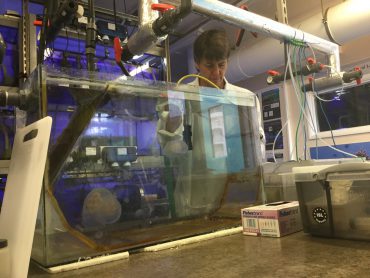 “This project I was involved in, Lucas says, was the first where we put together data available for the world’s oceans. Our study showed that there is no scientific evidence pointing towards a global increase in jellyfish.” A surprising conclusion backed by the research “Flawed citation practices facilitate the unsubstantiated perception of a global trend toward increased jellyfish blooms”. This study, published in the Global Ecology and Biogeography journal in 2016, found that 48.9% of scientific publications misinterpreted the conclusion of cited sources, and were biased towards claiming jellyfish populations were increasing. One particular review was singled-out as being the most influential in the network. The incriminated 2001 paper, in fact quite balanced, “may have been inadvertently responsible for seeding a chain of inappropriate citations since the title posed the question ‘Jellyfish blooms: are populations increasing globally in response to changing ocean conditions?’”.
“This project I was involved in, Lucas says, was the first where we put together data available for the world’s oceans. Our study showed that there is no scientific evidence pointing towards a global increase in jellyfish.” A surprising conclusion backed by the research “Flawed citation practices facilitate the unsubstantiated perception of a global trend toward increased jellyfish blooms”. This study, published in the Global Ecology and Biogeography journal in 2016, found that 48.9% of scientific publications misinterpreted the conclusion of cited sources, and were biased towards claiming jellyfish populations were increasing. One particular review was singled-out as being the most influential in the network. The incriminated 2001 paper, in fact quite balanced, “may have been inadvertently responsible for seeding a chain of inappropriate citations since the title posed the question ‘Jellyfish blooms: are populations increasing globally in response to changing ocean conditions?’”.
The scientific community is apparently divided. Are we back to square one? Far from it, luckily. As Cathy Lucas puts it, a healthy scientific debate was probably exactly what was necessary to go forward: “Indeed, some people say that jellyfish populations are increasing, and some people say they aren’t. What has this done? It has brought the field into more mainstream marine and biochemistry science. I experience a lot more people interested in jellyfish blooms, and they might be people working in the open ocean, or people interested in carbon flux, or molecular researchers or even cloning experts. It’s a bigger diversity of specialists, all interested in the type of research we are doing.”
 The subject is rapidly gaining interest, but there is a serious catching up to do. “Over the last five years, Cathy Lucas explains, a lot of research has been about trying to answer two questions. First, are jellyfish blooms increasing? And second, what is causing them? There are a multitude of factors, because of their complicated life cycle between the benthic polyp and the jellyfish themselves. It’s a very complex picture, mainly because we have to embed regional scale process like climate variability with locale scale process such as hydrodynamics. It’s challenging and it’ll keep me busy for the next 10-20 years. Ultimately, we wish to predict whether we will have a good or bad year for jellyfish and if they are going to impact power stations for example.”
The subject is rapidly gaining interest, but there is a serious catching up to do. “Over the last five years, Cathy Lucas explains, a lot of research has been about trying to answer two questions. First, are jellyfish blooms increasing? And second, what is causing them? There are a multitude of factors, because of their complicated life cycle between the benthic polyp and the jellyfish themselves. It’s a very complex picture, mainly because we have to embed regional scale process like climate variability with locale scale process such as hydrodynamics. It’s challenging and it’ll keep me busy for the next 10-20 years. Ultimately, we wish to predict whether we will have a good or bad year for jellyfish and if they are going to impact power stations for example.”
The Aurelia aurita, or Moon jellyfish, is one of the most studied species in the world. It measures only a few centimeters in diameter, yet it is able to stop some of the most sophisticated man-made structures in the world. The Oskarshamn plant, one of the planet’s largest nuclear reactors, had to be shut down for three days in October 2013. Situated in the south of Sweden, on the shores of the Baltic Sea, this power plant needs a constant input of sea water to cool down its reactors. This is why it was built next to the sea, very much like the Fukushima Daiichi plant in Japan. Massive quantities of Aurelia aurita were sucked into the cooling pipes, clogging the whole system and forcing an emergency stop.
“On the shores of the Baltic Sea, explains the French scientist Jacqueline Goy, there are several nuclear power plants. As we know, they use the cold water for their reactors. When the water is rejected back into the sea, it is much warmer than normal. This disrupts the biological cycles of the Aurelia aurita, which is a jellyfish that only reproduces in waters with a precise temperature. As the power plants discharge 16°C waters all year round, the Aurelia can breed constantly. My colleagues from the Baltic describe it as a jellyfish soup.”
These blooms are fascinating, by their scale and consequences. Despite our technological breakthroughs, we are constantly reminded that our actions can have serious and unforeseen repercussions.
Historically, jellyfish had been overlooked by science. Yet, they have been around for more than 500 million years, making them the most ancient multicellular organism we have on our planet. Surely, by studying them, we will keep learning.
